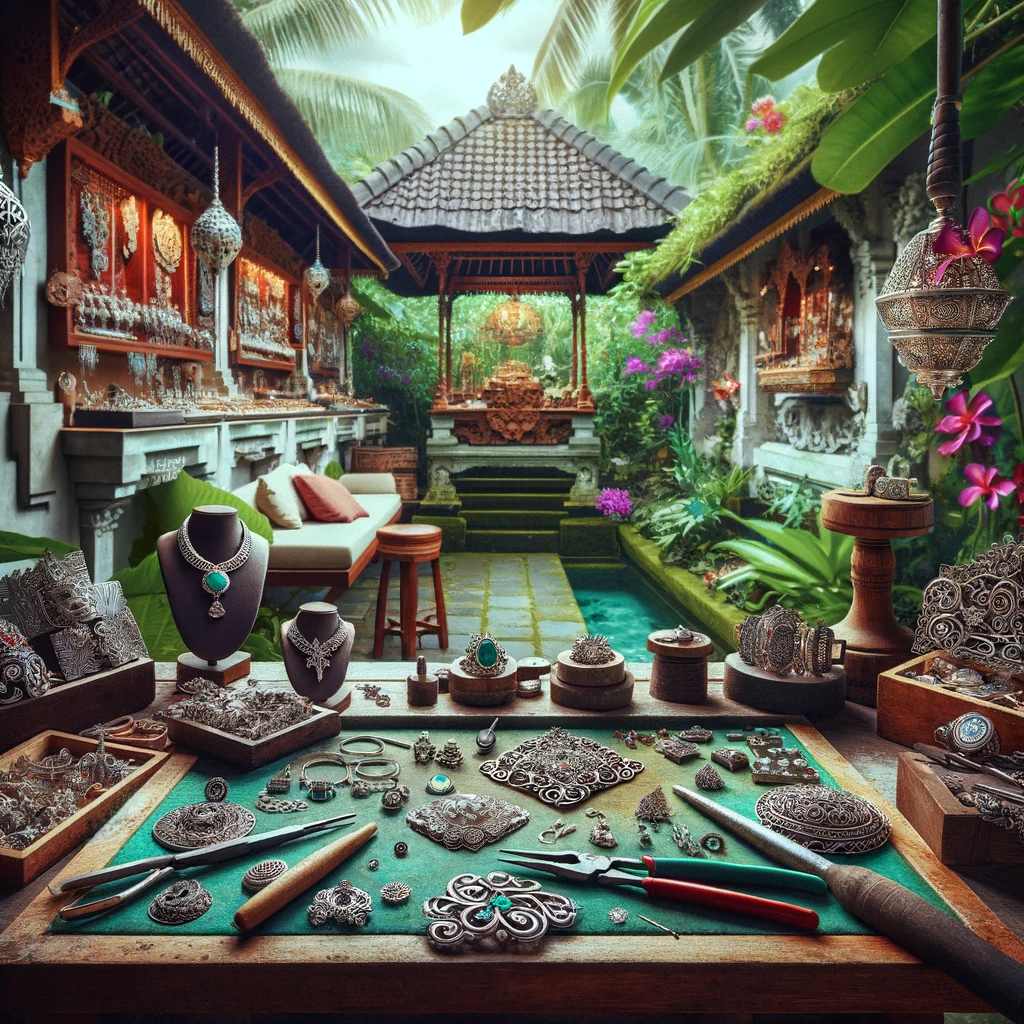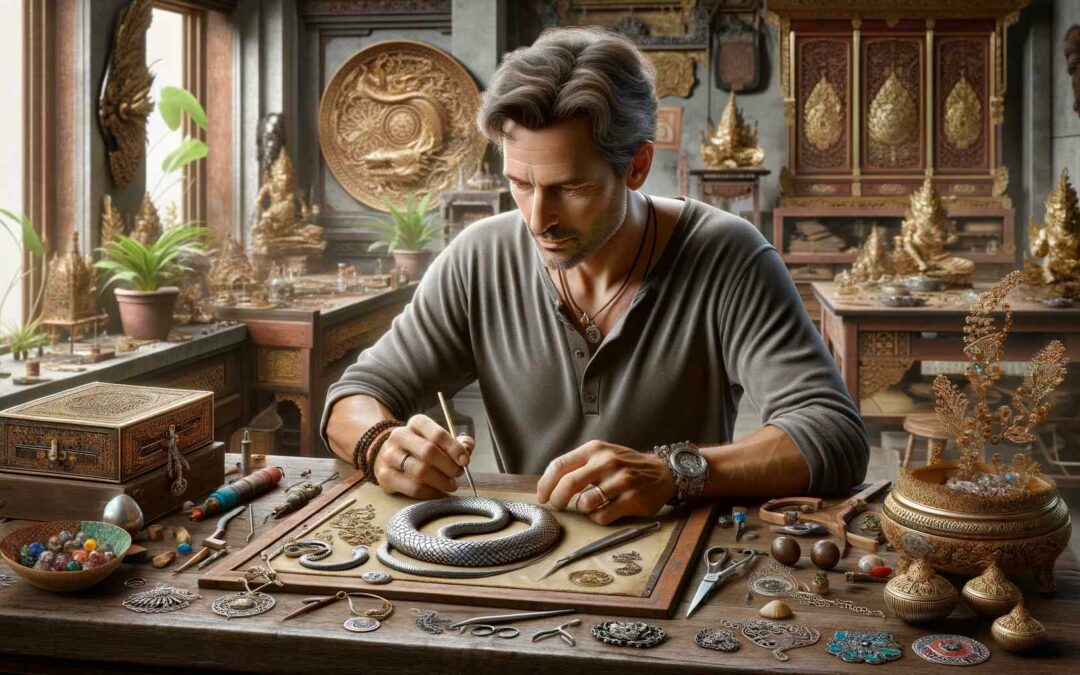Article Contents
- 1 Key Takeaways
- 2 Jean-François Fichot’s Impact on Balinese Jewelry Design
- 3 Snake Motifs in Ex-Pat Jewelry Design
- 4 Collaboration With Lapidary Artist Pedro Michel
- 5 Penny Berton: Another Ex-Pat Designer in Bali
- 6 Tragic Death of Jean-François Fichot
- 7 The Immortal Legend of Jean-François Fichot
- 8 Legacy Through Jewelry Designs
- 9 How Did Jean-François Fichot’s Jewelry Designs Influence the Joy of Gifting, Such as Giving a Diamond Necklace?
- 10 Speculations on Jean-François Fichot’s Rebirth
Key Takeaways
- Jean-François Fichot, a rebel jewelry designer, settled in Bali in 1978 after graduating from L’Ecole des Beaux-Arts.
- Snakes are commonly incorporated into jewelry designs by ex-pat designers in Bali, possibly symbolizing the allure of living in Paradise.
- Jean-François Fichot collaborated with Mexican lapidary artist Pedro Michel in Bali, discussing a project together around 20 years ago.
- Penny Berton, another ex-pat designer in Bali, settled around the same time as Jean-François Fichot and eventually shared a showcase with him at Treasures Gallery.
Jean-François Fichot’s Impact on Balinese Jewelry Design
The impact of Jean-François Fichot on Balinese jewelry design is significant and enduring. He settled in Bali in 1978 and was among the first rebel jewelry designers to explore the rich cultural tapestry of the island.Balinese culture had a significant influence on Fichot’s designs. He collaborated with Balinese goldsmiths and gem carvers, resulting in unique pieces inspired by Balinese temples and tropical foliage.Fichot’s ability to seamlessly blend his artistic vision with the traditional craftsmanship of Bali led to a new wave of creativity in the local jewelry industry.His legacy continues to inspire freedom of expression and cultural exchange, showcasing the lasting impact of Balinese culture on his designs and his influence on Balinese jewelry design as a whole.Jean-Francois Fichot moved to Bali in 1978, in an interview he noted, ‘My influences are drawn from the ancient world – a fusion of Mesopotamia, India, Egypt and Majapahit. I am very lucky to be working here in Bali because I have a group of very skilled carvers, gold and silversmiths.’According to an interview in the Jakarta post, in his youth Fichot studied interior design at L’Ecole des Beaux-Arts in Lyon, France, his hometown. Fichot said: “I studied interior design, but jewelry was my passion. I started to learn about stones and then I travelled to India and was caught by the people, the jewelry, the energy of the country.”
An Homage To Jean-François Fichot’S Influence In A Balinese Jewelry Workshop, Showcasing Intricate Silver And Gemstone Craftsmanship Surrounded By Bali’S Natural Flora.
Snake Motifs in Ex-Pat Jewelry Design
Jean-François Fichot’s influence on Balinese jewelry design extends to the incorporation of snake motifs by expatriate designers, reflecting the allure of Paradise and ancient mythology.The mystique of living in Bali has significantly impacted the symbolism of snakes in ex-pat jewelry design. This influence can be seen in various ways, such as using unusual gemstones, depicting ancient mythology, and the exotic allure of living in Paradise.The Balinese culture has also played a significant role in inspiring ex-pat jewelry designs, with its rich tapestry of myths and folklore. The presence of actual snakes in Bali may have further inspired designers to incorporate snake motifs, adding a touch of danger and mystique to their creations.Collaboration With Lapidary Artist Pedro Michel
In their collaborative endeavors, Jean-François Fichot frequently engaged with lapidary artist Pedro Michel, known for his exceptional skill in carving gem-quality material into intricate designs. Their collaboration in Bali involved discussions about a project twelve years ago.Notably, Pedro Michel is not only a master of gemstone carving techniques but also a shaman practitioner, bringing a unique spiritual dimension to their joint work. This partnership allowed for the fusion of Fichot’s visionary jewelry designs with Michel’s intricate carvings, resulting in truly exceptional pieces that reflected a blend of artistic expression and spiritual essence.The collaboration between the two artists showcased their individual talents and exemplified the potential for creative synergy between diverse artistic disciplines.Penny Berton: Another Ex-Pat Designer in Bali
Penny Berton, a contemporary jewelry maker from Toronto, established her presence in Bali around the same time as Jean-François Fichot. She eventually shared a showcase with Jean-François at Treasures Gallery, where her designs reflect her own artistic rebellion against Western conventions.Penny Berton’s contemporary designs are a testament to her artistic expression, capturing the freedom of living in Bali and rebelling against traditional jewelry norms. Her work at Treasures Gallery in Ubud represents a fusion of cultural influences, blending her Canadian roots with the exotic allure of Bali.Penny Berton’s jewelry pieces embody a sense of freedom and rebellion, challenging the status quo of conventional jewelry designs.Penny Berton’s Artistic Rebellion:
- Embracing unconventional designs
- Incorporating unique cultural influences
- Challenging traditional jewelry norms
Tragic Death of Jean-François Fichot
The tragic death of renowned jewelry designer Jean-François Fichot in a car accident in Cuba in July 2011 remains a significant event in the history of ex-pat jewelry design in Bali. The creative community in Bali was shocked by Fichot’s untimely demise, leaving a void in the industry and among those inspired by his work.It profoundly impacted Bali, where his legacy as a rebel jewelry designer and his unique collaborations with local artisans had become an integral part of the art scene. Fichot’s immortal legend lives on through his extraordinary jewelry designs, which continue to evoke the spirit of freedom and rebellion. His stunning diamond rings, crafted with meticulous detail and artistry, have captivated the hearts of art enthusiasts and jewelry aficionados alike. Each piece tells a story of boldness and creativity, reflecting Fichot’s daring vision and passion for pushing the boundaries of traditional jewelry design. His legacy continues to inspire and influence the art world, leaving an indelible mark on the industry. In addition to his artistic prowess, Fichot was also a pioneer in promoting ethically sourced diamonds, setting a new standard for sustainability within the jewelry industry. His commitment to ethical practices and environmental responsibility further cements his legacy as a trailblazer in the field. By championing the use of ethically sourced diamonds, Fichot not only created beautiful pieces of jewelry, but also contributed to the greater good of society and the planet.His tragic death serves as a reminder of the fleeting nature of life, yet his influence and artistic vision remain etched in the vibrant tapestry of Bali’s artistic heritage.The Immortal Legend of Jean-François Fichot
Fichot’s enduring legacy as a pioneering rebel jewelry designer and his influential collaborations with local artisans continue to shape the artistic landscape of Bali.His immortal legend is perpetuated through the following influences:- Balinese Influence
- The rich cultural heritage of the island was evident in Fichot’s designs, which drew heavily from Balinese temples and tropical foliage.
- His collaborations with Balinese goldsmiths and gem carvers resulted in unique jewelry pieces that captured the essence of Bali’s artistic traditions.
- The Balinese influence in Fichot’s work inspires and resonates with freedom-seeking individuals drawn to the island’s creative energy.
Legacy Through Jewelry Designs
Jean-François Fichot’s enduring legacy lives on through his timeless jewelry designs, which are imbued with the spirit of Bali and his visionary collaborations with local artisans.His influence on contemporary jewelry is undeniable, with his designs continuing to inspire and shape the work of present-day artisans. Fichot drew inspiration from the rich tapestry of Balinese culture, incorporating elements such as intricate temple architecture and lush tropical foliage into his creations.His innovative approach to jewelry design and his deep respect for Balinese artistry have left an indelible mark on the industry.The beauty and artistry of Fichot’s designs serve as a testament to his profound connection to the culture and people of Bali, ensuring that his legacy will continue to thrive for generations to come.If you visit Bali, take a look at Treasures Gallery in Ubud where you’ll find the work of three main designers: Jean-François Fichot, Carolyn Tyler and Penny Berton. The address is: Pengosekan Highway, Ubud, Gianyar, Bali 80571, IndonesiaHow Did Jean-François Fichot’s Jewelry Designs Influence the Joy of Gifting, Such as Giving a Diamond Necklace?
Jean-François Fichot’s jewelry designs transformed gifting into an art of meaning and elegance. His intricate creations celebrated individuality, making moments unforgettable. By giving diamond necklace designs inspired by his craftsmanship, people could convey love and sophistication, elevating the act of gift-giving into a timeless expression of emotion and appreciation.
Speculations on Jean-François Fichot’s Rebirth
- Speculations on the possible rebirth of the late jewelry designer, Jean-François Fichot, have sparked intriguing conversations within the artistic and spiritual communities. The enigmatic circumstances surrounding his death have led to various theories, including the belief that he may have been reborn.
- The Naga king theory has gained traction among the speculations, suggesting that Fichot might have been reincarnated as a mythical serpent deity. This theory draws from his deep connection to Balinese culture and spirituality and his fascination with serpent motifs in his jewelry designs.
- As discussions on rebirth continue, many are captivated by the idea that Fichot’s creative spirit and influence may endure through a new form, adding to his legacy’s mystique.

